 |  |
By Greg Niemann
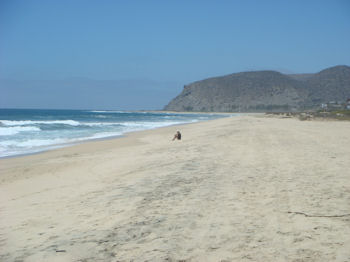
I found a captivating newer resort in an enchanting old setting, right on the Tropic of Cancer. Actually that imaginary globe-circling demarcation slices through two of my favorite Baja Sur towns (Santiago and Todos Santos), and this luxury boutique resort I discovered is in El Pescadero, just south of the latter. As the Tropic of Cancer crosses the peninsula just north of Cabo San Lucas, getting there is now an easy drive up the Pacific.
There the "tropico" slices through the artistic town of Todos Santos that has seen a lot of recent growth, and up to now most of it sustained. Only 50 miles north of Cabo San Lucas, the area has been slowly inundated with visitors as paved roads are now being widened to accommodate them.
Thus far Todos Santos – the locals are proud to say – remains low key, no high-rise monstrosities blighting the landscape and paving beach access, only simple thatch-roofed buildings and rustic retreats that poke out benignly between swaying palms, shady fruit trees, and fertile green fields.
The Todos Santos/Pescadero area was originally developed by Jesuit padres in 1724 who introduced farming to the local Indians. Juicy mangoes still drop from trees, pleasantly rendering a redolent, fruity aroma throughout broad valleys. Later, in the 19th century, mestizos came, planted sugar, built sugar mills and turned out small cones of panocha, a rich, dark brown sugar.
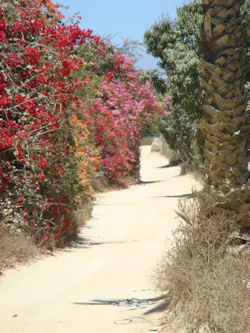
I first discovered the area in the 1970s, when the narrow dirt road wound its way up from Cabo San Lucas and continued north to La Paz. At that time, the main road went through a small farming/fishing community called El Pescadero, about three miles south of Todos Santos. I was enchanted by El Pescadero’s few rustic dwellings of mesquite branches and thatch, many buried beneath dazzling splashes of contrasting color – bougainvillea in hues from brilliant magenta to bright coral and orange, along with flaming red carnations. But the town was very small and did not even have a restaurant. That is not the case anymore.
El Pescadero is slowly growing; the paved road bypasses the original town to create a new village a little to the west. The whole area has been attracting Americans and Canadians who have been building permanent or vacation homes. Todos Santos itself has become an artist’s enclave, and daytrippers from Cabo and La Paz now wander about the picturesque cobbled roads, thick colonial buildings, and old sugar plantations. The old road entering town from La Paz and points north was paved in the early eighties and then in recent years transformed again into a wide four-lane highway. That widening is continuing all the way south to Cabo San Lucas. Unfortunately with the wider road, progress of the high rise variety is imminent.
Rancho Pescadero Sets New Standard
Meanwhile, there's Rancho Pescadero, a small ocean-front oasis, tucked away on a dirt road about 1 mile from the highway. As you enter the 15-acre property you know you're somewhere special when you pass the organic garden where herbs and produce are tenderly cultivated for the resort’s kitchen.
The 27-room luxury boutique hotel which opened with 12 rooms in December 2009 exudes class and quality in a relaxed, non-pretentious setting. I’ve spent nights around the world in lodging from stifling, overcrowded train cars to luxurious five star hotels, and with that experience Rancho Pescadero still stands out for its meticulous attention to detail. www.ranchopescadero.com.
It's the brainchild of designer Lisa Harper, former CEO of Gymboree, a Bay Area clothing firm, who with her personable husband, George Lilinoe, a former construction company owner, created the resort right on the broad, sandy beach. George, originally from Hawaii, says, "It’s all Lisa, she wanted that 'woman’s touch,' she made it special and her ideas have been ‘right on.'"
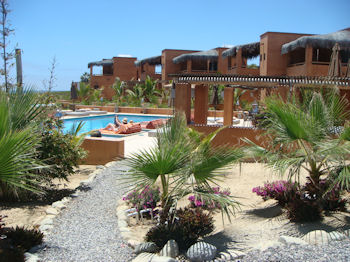
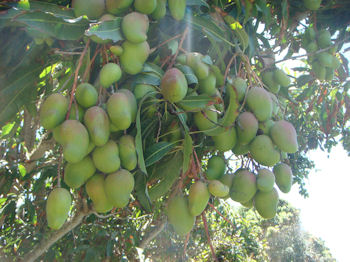
The ‘right on’ resort features suites that all open up to broad ocean-view terraces. All rooms have Jacuzzi tubs, step-down showers, big sinks, lots of fluffy towels, candles, games, robes, a pareau, flowers, and feature an attentive staff to ensure every expectation is met.
While my wife attended a Yoga class led by hotel manager Christine Sperber, I grabbed some hotel surf fishing gear and tried my luck. They regularly catch feisty rooster fish (pez gallo) and good-sized sierra from the shore here but I was denied in my only attempt. George, who fishes almost daily, chided me for starting too late. But hey, I was there to relax so I didn’t mind.
Then when my wife had a massage, the relaxing pool kept me captive for only so long. So I jumped on one of the hotel bicycles and pedaled around the area, up and down the dusty roads of the farming community. I saw bright melons ripening in the tropical sun, and locals wearing bandanas like Western outlaws harvesting fat red chiles.
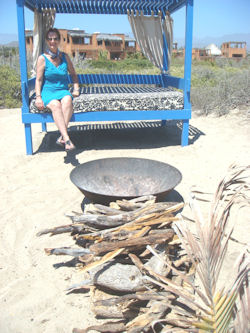
Along the closest road to the beach, I passed a couple small B&Bs and some rudimentary surf camps. If fishing isn’t your thing, try surfing. Along that long stretch of beach is a fine beach break at Cerritos, and the popular point break at San Perdito.
I later took a brief dip in the pounding surf and in the evening we enjoyed the simple beach cabanas and fire pits the hotel provides for its guests atop the dunes. They even supply the firewood.
The hotel's restaurant offers great meals and further spoils its guests with fresh coffee and a fruit plate delivered each morning. At night, gregarious George delights with guitar and hula lessons around a communal fire pit. I’d hate to see the place change.
What concerned me more was the area. I knew the dirt road days for through traffic were gone. But a broad four lane highway can only bring progress, and a few minutes south of El Pescadero the first multi-unit building was rising like a spectral intruder on a broad sandy beach. The local Mexicans told me they don’t want their area to become "another Cabo," but with progress comes opportunity. That two-edged sword will likely force them to accept changes. They live in one of the world’s most idyllic spots, and up to now their laid-back culture has been one of taking life as it comes. Almost prophetic, as if he envisioned an El Pescadero area, Henry Miller in his book Tropic of Cancer wrote, "Day by day. No yesterdays and no tomorrows. The barometer never changes…" Of course, Miller wrote that book before determined developers discovered Baja’s "Tropico de Cancer."
About Greg
Greg Niemann, a long-time Baja writer, is the author of Baja Fever, Baja Legends, Palm Springs Legends, Las Vegas Legends, and Big Brown: The Untold Story of UPS. Visit www.gregniemann.com.